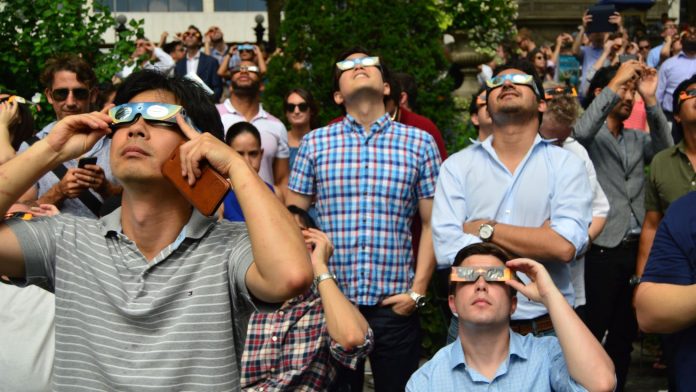On Monday, millions of North Americans will be looking at the sky during a total solar eclipse, when the moon will completely cover the sun for more than four minutes in some locations, LBC reports.
Nearly everyone in North America is guaranteed at least a partial eclipse, weather permitting. This promises to be the largest number of eclipse viewers in North America, thanks to the fact that the midday darkness will last up to four minutes in Texas and elsewhere. It will be another 21 years before the US sees another total solar eclipse of this magnitude.
The best weather is expected at the end of the eclipse in Vermont and Maine, as well as New Brunswick and Newfoundland. National Weather Service meteorologist Alexa Maines explained at Cleveland’s Great Lakes Science Centre on Sunday:
Cloud cover is one of the trickier things to forecast. At the very least, it won’t snow.
Eclipse fans are gathering at locations along the “path of totality,” including the city of Fredericksburg in central Texas, where the total eclipse will occur shortly after 1:30 p.m. (1830 GMT). That is where Michael Zeiler, a veteran eclipse chaser from New Mexico who already has witnessed 11 total eclipses across the globe, plans to be. He said:
First-time viewers of a total eclipse will be gobsmacked by the sight. It will be a peak life experience.
During a total eclipse, the Moon will slip directly in front of the Sun, completely covering it. The resulting twilight, in which only the Sun’s outer atmosphere or corona will be visible, may be long enough for birds and other animals to fall silent and for planets, stars, and perhaps even comets to become visible.
Unsynchronised darkness can last up to 4 minutes and 28 seconds. That’s almost twice as long as during the eclipse on the US coast seven years ago because the moon is closer to Earth.
On Monday, the eclipse will begin in the Pacific Ocean and reach the shores of Mazatlan, Mexico, before moving to Texas, Oklahoma, Arkansas and 12 other US states in the Midwest, Mid-Atlantic and New England, and then into Canada.
Protective glasses and filters should be used to observe the Sun, except when it is completely out of sight during an eclipse.
Experts from NASA and dozens of universities are stationed along the route, ready to launch research rockets, weather balloons and conduct experiments. Seven astronauts from the International Space Station will also be watching from an altitude of 270 miles (435 kilometres).
